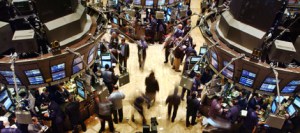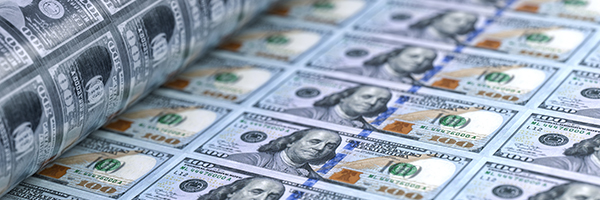
August 13, 2023 | Daily JAM, Jubak Picks, Millennial, Morning Briefing, PANW, Top 50 Stocks |
The key sentiment barometer I’m watching is Palo Alto Networks (PANW), down 13% in the last month on fears that Microsoft (MSFT) is going to gobble up the revenue growth in the cybersecurity space. I think that fear is overblown, at least when it comes to Palo Alto Networks. The stock has long been a favorite of growth stock investors and, if sentiment on market direction for the rest of 2023 is positive I’d expect strong buying in the shares ahead of the Friday, August 18, earnings report. The Wall Street consensus calls for the company to report earnings of 54 cents a share against 15 cents a share in the fiscal quarter a year ago.

August 11, 2023 | Daily JAM, Morning Briefing |
On Monday Moody’s Investors Service Ratings cut the credit ratings of 10 small and midsized banks. The company also put six big lenders on notice for a future downgrade assigning them a negative outlook.

August 11, 2023 | Daily JAM, Mid Term |
Credit card balances hit $1.03 trillion in the second quarter, up 4.6% from $986 billion in the preceding quarter, according to the Federal Reserve Bank of New York.
August 10, 2023 | Daily JAM, Morning Briefing |
CPI headline, all-items inflation rose at a 3.2% annual rate in July. That was up from the 3% annual rate in June and the first increase after 12 months of steady declines. But the uptick seems mostly an artifact of higher housing costs, an item that shows a longer-term downward trend in prices. The market read this morning is, therefore, that this is continued good news on inflation and that it cements the likelihood that the Fed will stand pat on interest rates at its September 20 meeting. The CME FedWatch tool put the odds of no increase from the Fed on September 20 at 90.5% today. That’s up from odds of 86% yesterday, August 9. But if the question of what the Fed will do in September is settled (in the market’s mind at least), the issue of what the Fed will do (or say) about the future direction of interest rates remains uncertain.

August 9, 2023 | Daily JAM, Jubak Picks, Top 50 Stocks, V |
Today’s Quick Pick is Visa (NYSE: V). Shares of Visa are showing a good trend reversal. From June through July, Visa’s stock began to pick up after sitting flat for some time. The reason for this jump? The company’s second-quarter report included a 13% increase in net revenue, a 9% increase in payment volume, and an increase in margins to 67.5% from 66.9% in the previous quarter. Visa is so embedded in the economy that it can actually outperform the economy. For example, Visa recently went to war with small merchants by lowering the permissible surcharge on credit card payments from 4% to 3% and the company has deployed inspectors to ensure merchants are abiding by that rule. That’s even though back in 2017, the Supreme Court decided that laws that regulate surcharge amounts were unconstitutional. Visa isn’t making a law, but they clearly have the market clout to put this kind of pressure on small businesses. The 20% of merchants that have imposed a surcharge on credit card use don’t seem to be affecting profit margins or growth for Visa. Morningstar calculates that Visa is trading at a 17% discount to fair value, although the trailing twelve-month PE is 30.2. Visa always trades at higher than a market multiple. The 5-year average PE is 35.6, so 30.2 actually looks like a discount. I own it in my 12-18 month Jubak Picks portfolio and will continue to hold it there. I am also adding it to my long-term 50 Stocks Portfolio.

August 9, 2023 | Daily JAM, Videos |
Today’s video Is Bank Lending Finally Starting To Get Tighter? The Federal Reserve regularly does an opinion survey of bank lending officers to ask if they’re seeing a tightening of credit standards on loans at their banks. In the most recent survey, 50.8% of banks reported tightening lending terms for medium and large business loans in the second quarter-up from 46% in the first quarter. They’re also reporting a rise in demand for loans. In the second quarter, 51.6% reported weaker demand, down from 55% in the previous quarter. We’re seeing the Fed’s policies slowly start to work. Eventually, this tightening will also hit the consumer level, making it more difficult to get a personal loan or a new credit card. This trend is something to watch as banks tighten their lending while demand remains steady.

August 8, 2023 | Daily JAM, Short Term, Uncategorized, Videos |
Today’s Trend of the Week is Are We Looking at a Supply Crisis for Treasuries? The federal deficit grew by $1.39 trillion in the first nine months of fiscal year 2023. That’s a huge addition to the deficit, an increase of 170% compared to the first nine months of 2022. The Treasury also recently increased its forecast for borrowing in the July-September quarter to another $1 trillion. This fast increase in the supply of Treasuries has been tough on the market. The Fed is trying to shrink its balance sheet and not buy as many new Treasuries. Private sector investors at auction are demanding a bigger discount. And because of the debt ceiling shutdown in new debt and the drawdown on the Treasury’s cash balances, the treasury has been issuing a lot of short-term bills to rebuild its buffer. Right now, however, Treasury is trying to move away from the short bills and looking to selling longer maturities. The market has little appetite for longer maturities as inflation seems to have staying power. Recent auctions on 7-20 year treasuries have been pretty weak. If you’re looking to buy 10-year Treasuries, look for an extra yield premium around 5% or so before the market is down dealling with as with this supply issue.

August 8, 2023 | Daily JAM, Morning Briefing |
There’s a good chance that the Thursday morning CPI inflation report for July will show a small step backwards in the Fed’s battle against inflation. Here’s the Wall Street consensus as of the end of last week according to FactSet.

August 6, 2023 | Daily JAM, Morning Briefing, Short Term |
Wall Street is starting to look past this quarter’s earnings recession and lick its chops at a return earnings growth in the third quarter. Earnings for the second quarter are turning out to be just as depressing as everyone anticipated. With 80% of the companies in the Standard & Poor’s 500 already reporting, earnings per share for the companies in the index are down more than 7% from the second quarter of 2022. this quarter will mark a third straight quarter of earnings declines. But, increasingly, Wall Street analysts are forecasting a return to earnings growth (if you exclude earnings from energy companies) in the third quarter.

August 2, 2023 | Daily JAM |
I’m headed to the big sand of Fire Island for a few days. Back in the saddle on Saturday.

August 2, 2023 | Daily JAM, Short Term, Videos |
Today’s video is What About That 2.4% GDP Growth Rate Surprise? Economists were expecting a 1.5% annual growth in the second quarter, but the first read reported a 2.4% growth rate–up from 2% in the first quarter. Where did the growth come from? Is the economy inexplicably stronger than anyone expected? Why haven’t the Fed rate increases dampened growth? How is inflation coming down as growth continues? There are suggested answers to these questions within the GDP report itself. The main explanation is that this trend, like all economic trends, is affected by lags. You can also see a shift in where the growth is coming from. GDP growth has recently a result of increases in consumption, while growth from business investments has been more subdued. Consumer spending was up in the most recent quarter, but it was only up 1.6%, not as high as the overall 2.4% growth rate. Where did the rest of the growth come from? Investments. Business investments came in at a 4.6% annual increase. Momentum built up by the Inflation Reduction Act, the subsidies and actual funding for business investment is still kicking in and we’re seeing an investment boom at the moment. Consumer spending going up 1.5% is positive, but what’s the trend on consumer spending? My guess is somewhere in the third or fourth quarter, we’ll see business investment peak and we’ll go back to a familiar growth pattern that focuses on consumer spending, where the Fed’s interest rates are more important.

August 1, 2023 | Daily JAM, Morning Briefing |
The big problem, in my opinion, is that the today’s action by Fitch Rating won’t be the last ding to the U.S credit rating. It’s hard of me to see a quick turnaround in any of the negative trends that Fitch cited as a reason for lowering its rating on U.S. debt to AA+ from AAA.














